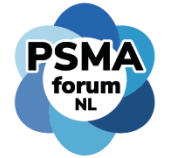What is Gallium-PSMA?
Gallium-68-PSMA is a radiopharmaceutical used to detect prostate cancer . A radiopharmaceutical is a radioactively labeled substance often used as a diagnostic or therapeutic agent.
In this case, PSMAdoes not refer to the protein in the cell membrane, but instead refers to a molecule that binds to the PSMA in the cell membrane of the cancer cell, a so-called ligand. It is important to bear this is mind to avoid confusion. After binding of the radioligand, the bound complex is transported into the cancer cell (internalization). Thanks to the radioactivity, a PET-CT scanner can create an image of the distribution of the radiopharmaceutical throughout the body and thus detect tumors, as these spots will have a higher radioactive activity.
Gallium-68 is the radioactive part of the radiopharmaceutical. The radioactive Gallium-68 can be extracted with a Germanium-68/Gallium-68 generator. By radioactive decay, Germanium-68 decays to Gallium-68, which can then be attached to the PSMA-11 molecule. This so-called radioactive labeling is done in a special laboratory (hot lab) in the hospital. Not all hospitals in the Netherlands have an accredited laboratory where this radioactive preparation may be performed.
In the Netherlands, hospitals mainly use 68-Gallium-PSMA-11, also referred to as 68Ga-HBED-CC-PSMA, for prostate cancer imaging. Based on experience in recent years, it has become clear that this type of scan is very good at detecting prostate cancer.
Gallium-68 has a half-life of 68 minutes. After production, the Ga-68-PSMA-11 should preferably be used as soon as possible, as the activity decreases quite quickly due to radioactive decay. Sufficient activity is required to make a high-quality scan. The short half-life of Ga-68 makes this product unsuitable for transport to other centers, and therefore the radiopharmaceutical containing Ga-68 is often only used locally at the production site.
If the Gallium generator is relatively new, it will be possible to extract radioactivity for 3 to 4 patients daily. As the generator ages, the yield decreases, and fewer patients can be supported each day. Typically, a generator is used for about 9 to 12 months. Some centers link 2 Gallium generators to uphold a consistent yield.
Partly due to the success of the gallium PSMA scan and the limited availability of the Gallium generators, the price has increased dramatically in recent times. The combination of price, availability and a relatively short half-life has ensured that the alternative Fluor-PSMA scan has made its mark.


A lab technician guides a patient during a PET-CT scan.

A lab technician guides a patient during a PET-CT scan.
